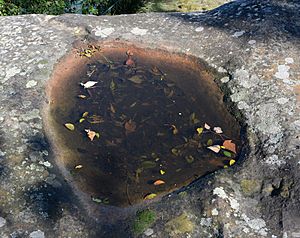Balls Head Reserve facts for kids
Quick facts for kids Balls Head Reserve |
|
|---|---|

Sydney red gum at Balls Head Reserve
|
|
| Lua error in Module:Location_map at line 420: attempt to index field 'wikibase' (a nil value). | |
| Type | Nature reserve |
| Location | Balls Head Drive, Waverton, North Sydney Council, New South Wales, Australia |
| Nearest city | Sydney |
| Designated | 1926 by Premier Jack Lang |
| Etymology | Henry Lidgbird Ball |
| Managed by | North Sydney Council |
The Balls Head Reserve is a beautiful forested area in Sydney, Australia. It's a special nature reserve located on a piece of land called Balls Head. This headland sticks out into Port Jackson, about 1.5 kilometers west of the famous Sydney Harbour Bridge. It sits between Berrys Bay to the east and Balls Head Bay to the west.
The reserve is named after Lieutenant Henry Lidgbird Ball. He was a Royal Naval officer who commanded the ship Supply during the First Fleet's arrival in Australia. You can visit this amazing park by going to Balls Head Drive in Waverton, New South Wales.
Contents
History of Balls Head Reserve
First Peoples of Balls Head
The original inhabitants of this land were the Cammeraygal people. They lived here for thousands of years. You can still find signs of their life today. These include special art sites and middens. Middens are ancient piles of shells and other food remains. There is also a fantastic petroglyph (rock carving) of a sea creature.
In 1964, an archaeologist found an Aboriginal burial site inside a rock shelter. Until 1916, the local Aboriginal community often visited the Balls Head area. The Aboriginal name for Balls Head is Yerroulbine.
European Settlement and Park Creation
Balls Head was originally part of a large property called the Wollstonecraft Estate. In 1912, the Australian Army took over the land. They set up a Quarantine Depot in Berrys Bay. This depot helped service boats going to and from the main Quarantine Station at North Head.
However, many people strongly protested in the early 1900s. They wanted Balls Head to be a public park. They didn't want it used for businesses or homes. Because of these protests, Balls Head officially became public parkland in 1926.
The famous Australian poet Henry Lawson wrote two poems about Balls Head. His second poem, 'The Sacrifice of Balls Head,' protested against plans to build a coal loading station there in 1916. This poem showed early feelings about protecting nature. A Coal Loader was built by 1920. Today, this facility is called the Coal Loader Centre for Sustainability. It's a place for environmental programs run by North Sydney Council.
The area was officially made a public reserve by Premier Jack Lang in 1926. By then, much of the forest Lawson wrote about was gone. A group called the Beautification Committee was formed in 1931. It was led by a conservationist named Walter Froggatt. They worked to reintroduce native trees to the headland. Many of these trees came from the Royal Botanic Gardens, Sydney. A stone tablet honoring Froggatt's work was put up in 1938. You can still see it near the car park today.
Today, North Sydney Council maintains the reserve. It has a well-preserved natural bushland area. It's one of the closest natural bushlands to the city of Sydney. You can find plants like the Sydney red gum, Port Jackson cypress, blueberry ash, and Port Jackson fig. Many birds live here, along with reptiles, flying foxes, microbats, and other native mammals.
Balls Head Reserve is a popular spot for picnics and bushwalking. It offers amazing views of the city skyline and the harbor.
What You Can Find at Balls Head Reserve
- Several bush walking tracks, including one that is good for wheelchairs.
- Accessible toilets, picnic tables, seats, and electric barbecues for visitors.
- Many plaques and old features from the 1930s. These include parts of paths, steps, and railings.
- Aboriginal waterholes and grinding grooves, showing ancient uses of the land.
- Foreshore caves and chambers that were cut by people living there in the 1930s.


